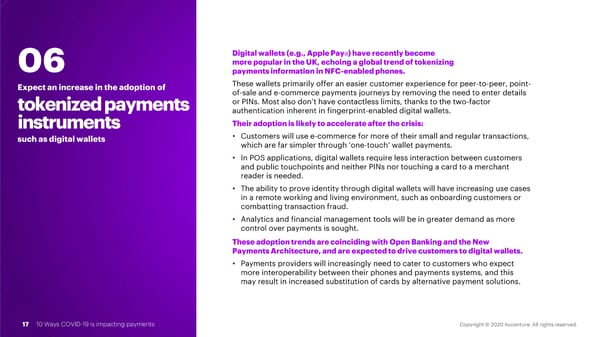Digital wallets (e.g., Apple Pay®) have recently become 06 more popular in the UK, echoing a global trend of tokenizing payments information in NFC-enabled phones. Expect an increase in the adoption of These wallets primarily offer an easier customer experience for peer-to-peer, point- of-sale and e-commerce payments journeys by removing the need to enter details tokenized payments or PINs. Most also don’t have contactless limits, thanks to the two-factor authentication inherent in fingerprint-enabled digital wallets. instruments Their adoption is likely to accelerate after the crisis: such as digital wallets • Customers will use e-commerce for more of their small and regular transactions, which are far simpler through ‘one-touch’ wallet payments. • In POS applications, digital wallets require less interaction between customers and public touchpoints and neither PINs nor touching a card to a merchant reader is needed. • The ability to prove identity through digital wallets will have increasing use cases in a remote working and living environment, such as onboarding customers or combatting transaction fraud. • Analytics and financial management tools will be in greater demand as more control over payments is sought. These adoption trends are coinciding with Open Banking and the New Payments Architecture, and are expected to drive customers to digital wallets. • Payments providers will increasingly need to cater to customers who expect more interoperability between their phones and payments systems, and this may result in increased substitution of cards by alternative payment solutions. 17 10 Ways COVID-19 is impacting payments
 10 Ways COVID-19 Is Impacting Payments Page 16 Page 18
10 Ways COVID-19 Is Impacting Payments Page 16 Page 18